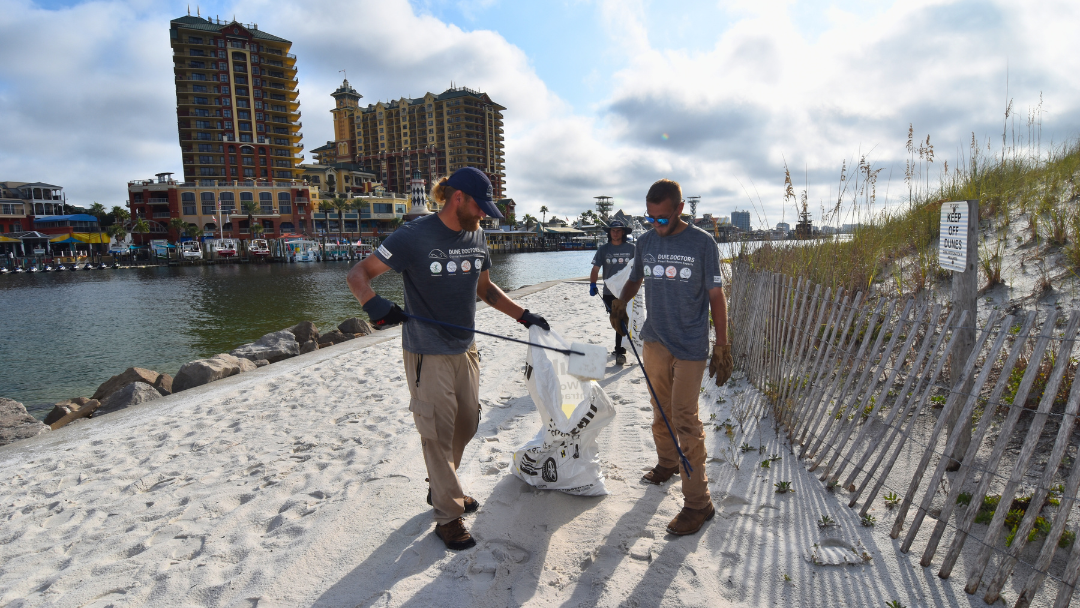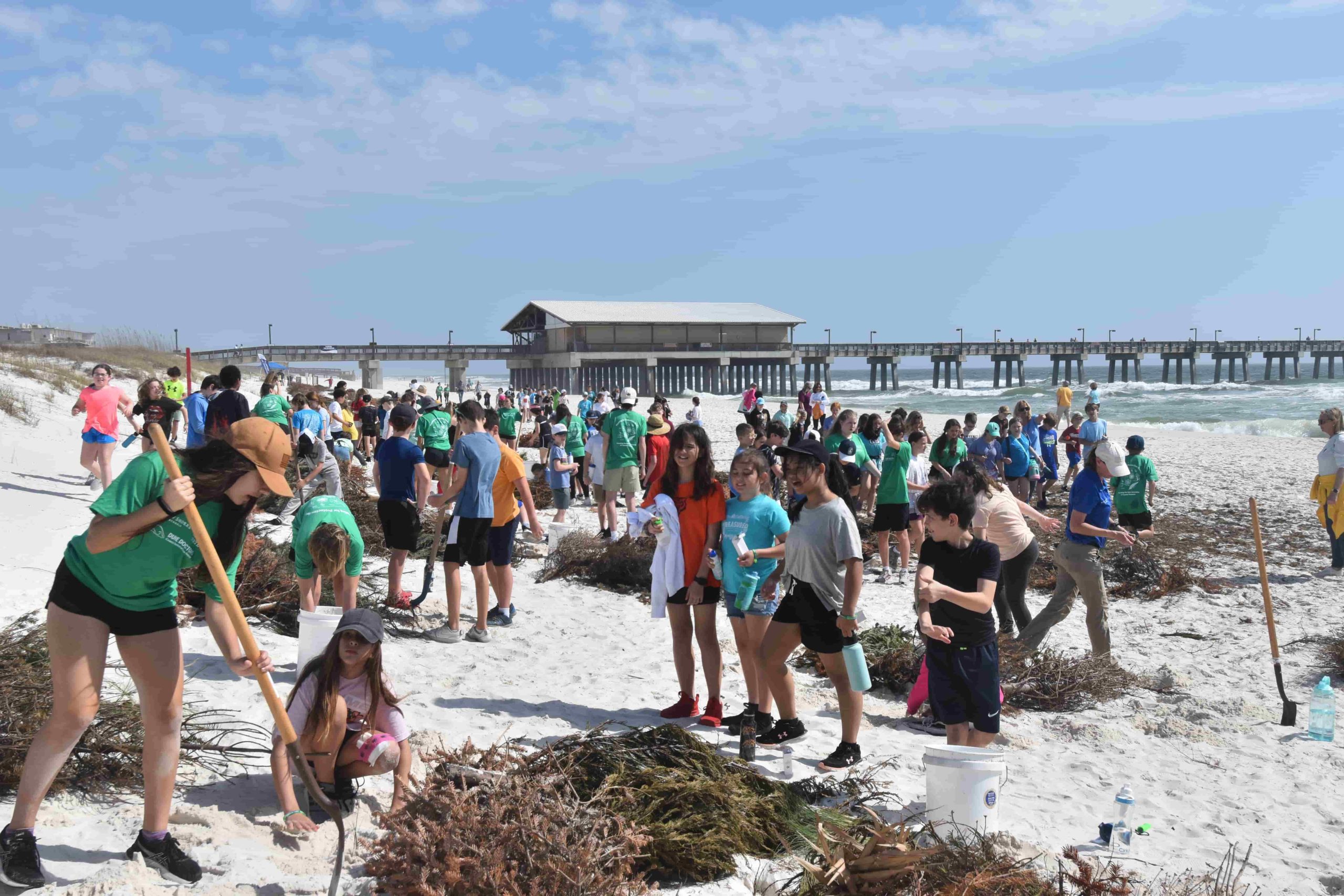- Article Highlight: Installing sand fences and dune-stabilizing vegetation is the most efficient and economical way to build new protective dunes.
- Key Takeaway: In Phase 2 of the Dune Master Plan™, Dune Doctors employs sand fences and native vegetation to initiate a new barrier, a berm, between the coastal homeowner and water-borne threats.
- Take Action: Join other forward-thinking communities by calling 866-386-3737 or filling out this form to request a sand fence installation and join our waitlist today. Watch the video below to understand how sand fences build stronger dune systems.
Why Are Coastal Dunes Important?
Healthy, well-maintained coastal dunes are natural barriers that protect communities and ecosystems from the destructive impacts of storm surge and high waves. In simplest terms, a vegetated dune is a barricade that buys time. A storm will only last so long. Therefore, the greater and healthier the dune, the longer it will take for wave action to breach it and cause damage landward. However, waterfront construction and foot traffic have changed the dynamic of where and how dunes form, leading to weakened protection and heightened erosion. Most coastal communities tend to have a dune system, whether that be an established dune or scattered mounds with sparse vegetation. To increase their protection, Homeowners and Property Managers can work with Coastal Restoration Experts to fortify and enhance this natural barrier. At Dune Doctors, we identify any established dune as the “existing dune,” and the core of coastal resiliency is to strengthen and increase this native landscape by adding berms, seaward of the existing dune.
How Do Sand Fences & Native Vegetation Counter Coastal Erosion?
The evolution of a dune system depends on the cycle of sand accretion (accumulation of sand) and erosion (loss of sand), wind patterns, storm action, sand availability and other environmental conditions. However, because of the combination of natural and man-made factors, this cycle of sand loss and sand accumulation is often unbalanced, and many areas experience heightened erosion. To help coastal communities address sand loss, Dune Doctors works with regulatory agencies to install wildlife-friendly sand fences that are optimized to capture wind-blown and wave-pushed sand. Following environmental regulations, Dune Doctors installs sand fences at a 45 degree angle in alignment with the dominant coastal wind patterns that blow along the Gulf Coast. Moving sand collides with the fences and the particles drop, temporarily accumulating around the base of the fences. While effective in capturing sand, the fences alone cannot hold the sand in place. Therefore, to successfully stabilize the shifting sand, native vegetation must be planted between the fences. As the fences capture new layers of sand, the plants grow through it and anchor it in place with their massive, web-like root systems.
Are Sand Fence Installations Enough to Achieve Coastal Resiliency?
Sand fences fulfill one critical component of achieving coastal resiliency: adding a new barrier seaward of the existing dune. However, installing sand fences without addressing erosion issues and failure points throughout the existing dune undermines the developing berm. Underlying erosion issues may include a storm runoff that drains seaward, an irrigation system that over reaches on to the dune and kills dune-stabilizing vegetation, or a footpath that cuts through the dune creating an area where storm surge is likely to breach the dune. In all three cases, any sand the fences may accrete will not make up for the ongoing erosion. Without a comprehensive approach that cares for the entire dune system, once surge erodes the developing berm, it will easily carve away at the remaining weak landscape and flood ground-level infrastructure. Therefore, the strategy of building new lines of defense needs to align with a concerted effort to optimize and enhance the rest of the dune. To solve the issues impacting an at-risk dune system and strategize ways to increase its protective value, our Coastal Restoration Experts designed the Dune Master Plan™ (DMP™) a long-term roadmap for coastal resiliency. Through four interconnected phases, the DMP™ addresses every aspect of building and maintaining a protective dune system while being in compliance with environmental regulations. The installation of sand fences and native vegetation seaward of the existing dune falls under Phase 2 of our Dune Master Plan™. To obtain a personalized DMP™ contact Dune Doctors today at 866-386-3737 or click here to fill out our contact us form. To read about the three other recommended phases that make our DMP™ a thorough, long-term vision for your protective landscape click here.
How do Sand Fences Build Stronger Dunes?
Sand fences build stronger dunes by accelerating sand accretion and dune evolution. As sand accumulates and buries the fences, the existing dune behind the row of sand fences also gains sand. Within two to four years, enough sand will accumulate to bury the fences and cause the developing berm and existing dune to merge. Dune Doctors encourages coastal communities to continuously strengthen their native protective landscape by adding new rows of fences and dune-stabilizing vegetation each time a sand fence installation is entirely buried under 4 feet of sand. While the dune’s height is important the continuous form of the barrier is also equally critical. Storm surge will push through grooves and breaks in the protective berm, so proactive neighbors can build protection together by connecting their sand fence installations. As the dune increases in volume, width and length, the likelihood that storm surge will breach it decreases.
How Do Sand Fences Create “Sand Banks”
Sand fences paired with native protective vegetation initiate a “sand bank” in the shape of a continuous protective berm that acts as a buffer between your property and destructive wave action. Over time, the fences capture wind-blown sand, and the plants stabilize each new layer, enhancing and accelerating sand accretion. Think of this “sand bank” as a financial institution that allows for storm events to “withdraw” from your sand savings instead of eroding the dune closest to your property or the foundation of your building. The dune closest to the building, is the dune-of-last-resort. If surge erodes it, the destructive wave action will likely cause extensive damages and force the property to be shut down until all repairs are implemented. Therefore, building up your “sand bank” is critical to avoid these costly damages.
What if a Storm Damages the Sand Fence Installation?
If a storm erodes a portion of the developing berm and compromises the sand fence installation, that does not mean the restoration project failed. The damages are often proof of the installation’s success because that berm, built with free sand, absorbed the brunt of the storm surge and protected waterfront infrastructure. After an installation by Dune Doctors sustains damage, our team repairs the reusable fences and replaces the rest to continue the process of sand accretion. While it takes two to four years for the fences to accumulate 4ft of sand, enough to bury its posts, the protection the installation provides starts early on. Greater protection is achieved with each new layer of sand. If 11 sand fences capture only 1ft of sand across the entire installation, that means the property’s protective barrier increased by an estimated 8 tons of sand or roughly four average-sized dump trucks worth of sand. Destructive storms are increasing in frequency, but coastal communities can mitigate future losses by building a sacrificial berm that can hold back destructive waves long enough for the storm to pass without breaching the dune system and causing damage landward.
Proper Sand Fence Installation is Critical for the Safety of Beachgoers and Wildlife
Sand Fences should never be installed on the beach with the purpose of sectioning off your property as wildlife may find its way there and become disoriented and trapped by the fencing. Coastal homeowners who endanger wildlife or beachgoers with poor fence installations can be heavily fined and will face further legal consequences if any harm occurs. We always recommend following all the guidelines designed by local and federal regulating authorities. As per those guidelines, our sections of fences are angled to allow the free movement of animals. At Dune Doctors, we can help you navigate the policies designed to protect wildlife and obtain the necessary permits for sand fence installation on your behalf. The coastline is in a constant state of change as numerous powerful forces contribute to the cycle of sand accretion and erosion. The challenge is designing and implementing ways to channel this natural sand relocation and determine where its placement will be the most helpful. Dune Doctors has over twenty years of experience helping coastal communities use sand fences and native vegetation to achieve the highest level of sustainable coastal resiliency and can help you do the same.






